
|
|
|
||||

|
China Moon (1994)
This contemporary, twisting neo-noir romantic thriller, similar to Body Heat (1981), was the directorial debut film for John Bailey. Its tagline was:
It opened (under the credits) with an unidentified couple registering at the Calypso Heaven Motel, entering a bedroom, and making love. [Note: Someone had been hired to spy on them and take incriminating photos - later revealed in a very surprising twist.] Meanwhile, two cops were investigating a messy homicide of a black female named Felicity Turner (Theresa Bean). The partnered officers were:
During the autopsy, one of Bodine's partners remarked: "Kill someone in Brayton, Kyle Bodine's gonna get ya." The intuitive and observant Bodine later admitted: "I see life in all its dirty details." Then at JJ's Lounge, Bodine met unhappily-married, irresistible and mysterious love interest femme fatale Rachel Munro (Madeleine Stowe), not knowing at first that she was stuck in an abusive, loveless marriage to domineering, wealthy banker Rupert Munro (Charles Dance) - who was having a "wild sexual affair." He was the one who had been cheating at the motel with his curly-haired blonde bank secretary Adele (Patricia Healy). When Rachel began her own torrid affair with Bodine, she told him: "I'm in a trap. I can't get out of it." He foolishly promised: "Whatever I got, it's yours. Whatever you want, I'll get. Whatever you need, I'll do." Bodine and Lamar were summoned to the Munro house after a report of domestic violence, but a bloodied Rachel didn't press charges for Rupert's arrest (who had recently learned that she was also having an extra-marital affair). She later told Bodine: "I want to get rid of him" - but not by obtaining a legal divorce. Rachel contemplated killing him with a recently-purchased 9-millimeter gun, by first traveling by air to Miami on Thursday, checking into a hotel for a 4-night visit, driving back to Brayton in the middle of Saturday night in a rental car, and murdering her husband. When she drove back to Brayton to execute her plan, Bodine enticed Rachel to run away with him, but they first had to make a brief visit to the Munro house (for her to pack a bag) in the middle of the night. When her drunk husband unexpectedly returned and tried to rape her ("I just want my conjugal rights...You're not goin' anywhere!"), Rachel shot him in self-defense. When Bodine came upon the body, he encouraged her to call the police, stating it was "justifiable homicide," but then became entangled when he found himself helping her to cover up the murder and avoid notification of the police. She convinced him to help ("If you ever loved me, trust me now"), by telling him it was an unregistered gun and that she hadn't checked out of her Miami hotel. However, it looked bad for her, as if she had committed pre-meditated murder. Together, they drove the bundled-up, weighted and bloodied corpse to Camelia Lake to submerge it, and cleaned up all evidence of the crime at the murder scene. Bodine prophetically cautioned, fearing that they had sealed their fates
Rachel returned to her Miami hotel, not realizing she had been trailed by Rupert's secretary Adele and that the secretary had entered her hotel room and made calls to Rupert (calls which Rachel denied making)! After she reported her husband missing, Rachel (and an unknown male accomplice) became prime suspects. Lamar called Rachel a "cuckoo bird" and then added: "If this was murder, someone knew what they were doing. It wasn't no cuckoo bird." He suspected that Rachel "got one of her lover boys to come over here and kill him." During the investigation, Bodine began to distrust and become suspicious of Rachel, wondering to himself: "Somebody's lying. This doesn't make any sense," and he indignantly questioned her contradictory version of part of the story. With an anonymous tip [from Lamar, calculating the round-trip distance from the odometer reading], the police dredged Camelia Lake and found Rupert's body, and the tale became a murder mystery.
As he became a prime suspect, Bodine recalled his earlier words: "Murderers are dumb s--ts. They always screw it up sooner or later." He was grilled by the police and asked: "What are you protecting her for, Kyle?...Smarten up, Kyle. You're gonna fry for this, and she's gonna walk." Rachel was due to receive $12 million from her husband's trust, and Bodine was facing prison time if he agreed to cut a deal with the state attorney. Then, another twist came from out of the blue - Bodine's duplicitous buddy Lamar was scheming with Rupert's secretary Adele, and had been paid by Rachel to follow Rupert and take incriminating photos so that she could maximize a divorce settlement payment. Bodine put two-and-two together when he recognized a globe-directional compass in the photos (that he discovered and secretly took from the Munro house) and on Lamar's car dashboard. Under duress applied by Bodine, Rachel admitted that Lamar had advised her how to ensure that she would receive a large inheritance payment if her husband died. She was told how to set up Rupert's death, where to meet Bodine - also "the gun, Miami, everything." In fact, Lamar had designated Bodine as the fall-guy. Bodine sensed that he had been betrayed and double-crossed by her, and been made an accomplice to the murder: "So we were just a lie." But then she told him how "it changed after I met you" - how she was really still in love with him. And she again claimed she didn't know who made phone calls from her Miami hotel room to Rupert! She professed that she was telling the truth, although he was indignant and called her a "stranger." He grabbed her neck and accused her of lying: "You were just f--king me, weren't you? I was loving you, and you were f--king me!" At JJ's Lounge, Lamar was confronted by Bodine, and was shown the bullet (pitted with sand) taken from Rupert Munro's body. Bodine figured out that Lamar had switched his .38 gun, shot it into sand, and then planted the used .38 slug in the autopsy room - switching it with the 9-millimeter slug actually pulled from Munro's chest. To set Bodine up, Lamar had also fired Bodine's .38 into the Munro bedroom wall, so the slug from the wall and body matched - both from Bodine's gun! Bodine told his buddy:
When they went to the parking lot outside the bar to get Bodine's gun in Lamar's car, a patrol car arrived and an unexonerated Bodine was shot dead. Tragically, as Rachel cradled him in her arms and begged "stay with me," he died with his final words: "I was never gonna leave you." Lamar reminded Rachel: "Kyle was right. Sooner or later, they all f--k up." Rachel shot the pernicious Lamar dead with Kyle's gun. The camera panned up to a china moon. |
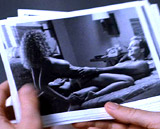 Incriminating Photos of Rupert Munro - Cheating with Secretary Adele (Photos Were Taken by Lamar, and Paid For by Rachel)  Femme Fatale Rachel Munro (Madeleine Stowe)  Rachel Shooting Husband in Self-Defense 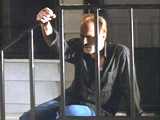 Kyle Bodine (Ed Harris) 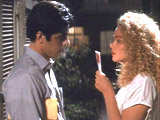 Lamar With Adele  Noticing a Globe Directional Compass (in Lamar's Car) in Photos  Indignant Anger at Rachel For Being Lied to  Kyle Accusing Lamar of Setting Him Up   Kyle Shot to Death by Authorities  Rachel Shooting Lamar with Kyle's Gun |
||

|
In this superb detective noir film set in early 20th century Los Angeles during a water rights scandal investigated by LA private eye J.J. "Jake" Gittes (Jack Nicholson), the most-discussed scene involved the revelation of the identity of the alleged "mistress" of the suspected philandering water commissioner Hollis Mulwray (Darryl Zwerling), the husband of wealthy Evelyn Mulwray (Faye Dunaway). While he repeatedly slapped her, Gittes learned from the secretive Evelyn, now his troubled and newly-widowed client, that she had been incestuously raped by her ruthless tycoon father Noah Cross (John Huston) and had conceived a teenaged daughter Katherine (Belinda Palmer) from that union:
In the film's conclusion set in Chinatown, when Evelyn tried to escape in a convertible with Katherine, she was tragically shot and killed by a policeman, as Katherine screamed in horror and was comforted by a leering Cross. The tragic ending included the haunting closing line told to Jake: "Forget it, Jake, it's Chinatown." |
 Evelyn: "She's My Sister...She's My Daughter"  Evelyn Shot to Death 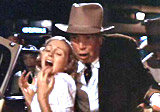 Noah Cross with Daughter of Incest Katherine 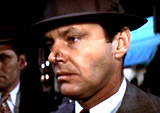 "Forget it, Jake, it's Chinatown" |
||

|
The Cincinnati Kid (1965)
Director Norman Jewison's drama, set in New Orleans during the Depression era, was based on prolific author Richard Jessup's novel, adapted by ex-blacklisted scriptwriter Ring Lardner Jr. and Terry Southern. Its tagline was:
The film was noted for its climactic and suspenseful showdown - a 5-card stud poker game (with open stakes) that began with six players, who were finally dwindled down to two:
In a highly unusual outcome, The Kid's full-house (with Aces and tens) was beaten by "The Man's" Queen-high straight flush (when he turned over a Jack of Diamonds) - accentuated by close-ups. The "Kid" admitted: "I'm through," although Lancey complimented him on a good game:
|
 Lancey Howard - "The Man" (Edward G. Robinson) 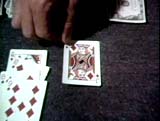 Turned-over Jack of Diamonds Revealing Straight Flush 
|
||

|
One of the best-known spoilers and greatest twist endings of all-time was the iconic revelation of the meaning of the mysterious Rosebud -- publisher tycoon Charles Foster Kane's (Orson Welles) last word uttered from huge, rubbery lips as he died. Rosebud was the name of Kane's boyhood sled (painted with a decorative, blooming flower that symbolized lost innocence) that was briefly glimpsed as it burned in a pyre in the basement of Xanadu, when a worker was told by butler Raymond (Paul Stewart) to: "Throw that junk." However, the word's meaning was still elusive and explained only one small part of the giant jigsaw puzzle that was the life of Kane. |
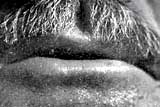 Final Words: "Rosebud" 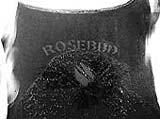 Rosebud = Kane's Childhood Sled Burned in Pyre |
||
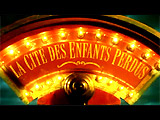
|
The City of Lost Children (1995, Fr.) (aka La Cité des Enfants Perdus)
This surreal French film, by co-directors Marc Caro and Jean-Pierre Jeunet, was a dream fantasy science fiction tale about a strange, futuristic-retro dystopian world. In a seaport town, kidnappings of innocent young children from their homes were being conducted by one-eyed, part-mechanical cultists called Cyclops. Led by Gabriel Marie (Serge Merlin), they were a cultish group of individuals, possessing a mechanical, video-camera third eye (an Optacon), worn over their left eye, to provide vision. They also had hyper-sensitive advanced hearing devices. They were sneaking through dark alleys stealing children, to provide young subjects for the dream experiments of morose, bald-headed, mad scientist Krank (Daniel Emilforth). Krank would often dress in a Santa Claus outfit to calm the children, but it had the opposite effect. Krank lived in a laboratory located off-shore on a coastal oil rig surrounded by a minefield. He had been created by the Inventor to be his son, but a genetic flaw prevented Krank from dreaming, and caused him to age rapidly. [One of the film's revelations was that Krank was born genetically engineered - the reason for his inability to dream.] Suffering from a lack of dreaming, and because he had grown prematurely old (and wanted to slow his aging), he went about using kidnapped children to extract and steal their dreams. Krank's efforts to tap into the children's brains were hopelessly unsuccessful, because the traumatized children only experienced nightmares. Other unusual and bizarre elements in the film included:
The main story was about the kidnapping of a fearless blonde 5 year-old orphan (known for loud burps) named Denree (Joseph Lucien). The boy was the adopted 'little brother' of a silent, kind-hearted circus sideshow Strongman named One (Ron Perlman). One's efforts to rescue the boy were aided by precocious, pretty 9 year-old Miette (Judith Vittet), the leader of an orphan band of pickpockets. Others that helped in the rescue included the drug-addled flea-circus master and The Diver. They found their way into Krank's laboratory via a map tattooed on the skull of an elderly Asian man. By film's end, Miette substituted herself in Denree's place in Krank's dream machine - but turned her dream-world against him. Krank regressed in age and was kidnapped and hooked up to the dream machine just like the kidnapped children had been. This caused him to suffer a heart attack and he expired while hooked up to his own dream machine. Krank's oil rig was blown up after all the children were rescued. One of the film's most remarkable sequences was the Rube Goldberg-like chain of events of a teardrop, ultimately causing a fog-bound freighter to crash into a pier during a blackout.
|
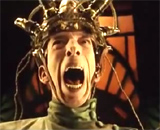 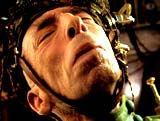 Krank (Daniel Emilfork)  Irvin: Talking Brain 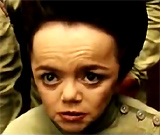 Miss Mismuth (Mireille Mosse) 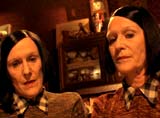 Evil Conjoined Female Twins: 'Octopus'  The Diver (Dominique Pinon)  Some of The Clones  The Strongman One (Ron Perlman)  Denree (Joseph Lucien)  Miette Hooked Up to Krank's Dream Machine |
||

|
Stanley Kubrick's film could best be described by its tagline:
In the nihilistic ending adapted from the Anthony Burgess novel (without including the last chapter in the film adaptation), it was learned that juvenile droog Alex (Malcolm McDowell), 'cured' of being an ultra-violent youth in futuristic England, had attempted suicide after his cruel behavioral conditioning, and was hospitalized. The Minister of the Interior (Anthony Sharp) explained to bed-bound Alex, as he was spoon-fed, how he had authorized the undoing of the effects of the Ludovico Technique and was attempting to restore Alex to his previous condition (with the freedom of choice and therefore the right to take pleasure in violence). He promised to help restore Alex with a good job and salary, in exchange for Alex publicly absolving the government for its inhumane Ludovico Technique experiments. The Minister effectively seduced Alex over to the government's side:
It was apparent that Alex had learned nothing from his behavioral modification treatments by the state. He was returned to his former self - with his free will intact and with his old proclivities for sex and violence. After giving a thumbs-up signal to the press and mugging for the cameras, Alex's eyes glazed and rolled back (in a semi-Kubrick stare with facial contortions), and he found peace as he fantasized a pseudo-orgy while trapped in his hospital bed. He saw himself copulating (making love to/or raping?) with a beautiful blonde woman who wore only black silk stockings - they were frolicking naked in slow-motion on piles of white snow, while two rows of genteel-looking, Victorian Londoners (ladies and gentlemen), the men dressed in top hats and the women carrying parasols, looked on and sedately applauded toward them. Alex had reverted to his old, pre-conditioned behavior, as he triumphantly and sardonically said, in voice-over:
|
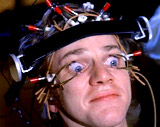 Averse Therapy and Behavioral Conditioning For Alex (Malcolm McDowell) 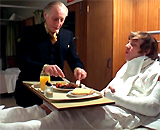 The Minister of the Interior Spoon-Feeding Alex 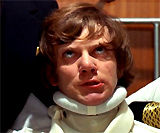 Alex's Eyes Rolling Back   "I Was Cured All Right" |
||
 
|
Close Encounters of the Third Kind (1977)
E.T.: The Extra-Terrestrial (1982)
Totally in contrast to the evil alien-invasion films of the 50s and afterwards, Steven Spielberg's two films depicted other-worldly aliens as benevolent beings in their contact with humans - a major plot twist and reversed cliche within the science-fiction/adventure film genre. The aliens in these two pictures were playful, curious about human life, interested in observing human nature, and decidedly friendly, and their encounters were seen as magical and awe-inspiring. Audiences were kept on edge, however, because the knowledge that the aliens were peaceful, non-hostile, non-malicious and harmless wasn't revealed fully or known by everyone at the start. |
    Close Encounters... 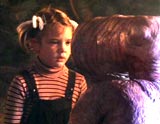 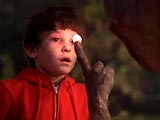 Saying Goodbye to Friendly E.T. |
||

|
Club Dread (2004) (aka Broken Lizard's Club Dread)
Director Jay Chandrasekhar's film was a combination horror-comedy spoof, including elements of the murder-mystery And Then There Were None (1945), the series of bloody Friday the 13th slasher films, I Still Know What You Did Last Summer (1998), stoner dialogue, a serious Scary Movie (2000), low-brow raunchy comedies, Jimmy Buffett, and lots of T&A of the Girls Gone Wild variety. It told about a tropical Costa Rican beachfront vacation spot named Pleasure Island where has-been rock star owner Coconut Pete (Bill Paxton) and staff were plagued by a series of machete-murders. The staff were warned that they were not to tell the guests of the onslaught of killings, so the activities at the resort continued. Some of the murders seemed to match up to the lyrics of Coconut Pete's songs. After a number of ambushes, stabbings-slashings, beheadings and other murders (electrocution by a television thrown into a pool, for example), there were any number of suspect possibilities:
The killer was revealed to be Sam, whose motivation was jealousy over Coconut Pete giving the island away to his nephew DJ Dave. When his identity as the killer was revealed, Sam was hiding in the mudbath room, where he held a machete to the neck of Lars. In the prolonged conclusion, Lars, Jenny, and resort guest Penelope (Jordan Ladd) fought off Sam, and were able to slice him in half with rope twisted tightly around him as they circled a floating dock with a motorboat. He screamed out as his torso was split in half, and his legs bloodily descended into the water, although he continued to comically lunge at them (even though his torso was split in half). As "The End" title came on the screen, Sam's disembodied legs were still kicking through the water. |
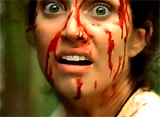 The Death of Stacy (Elena Lyons) - One of the Film's Many Bloody Murders  Sam - The Machete Slasher  Jenny and Penelope Fighting Off Sam    Sam's Torso Split in Half |
||